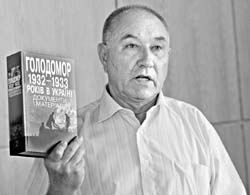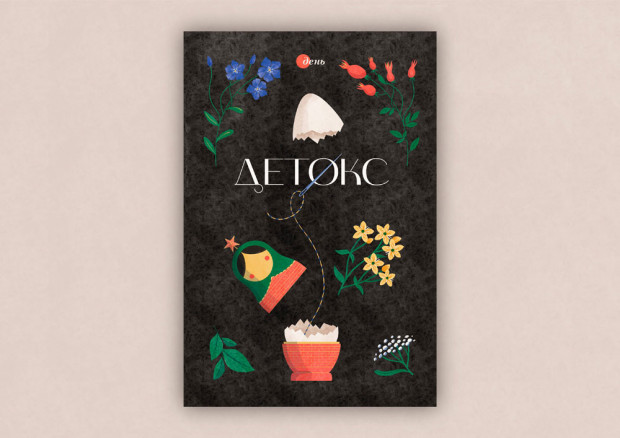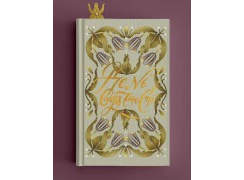Ruslan PYRIH: “This book is the quintessence of what we know about the Holodomor”

As The Day has already reported, Kyiv-Mohyla Academy Publishers have just published a fundamental study entitled Holodomor 1932-1933 r.r. v Ukraini. Dokumenty i materially [The Holodomor of 1932-1933 in Ukraine: Documents and Materials]. This compilation contains several hundred documents that provide evidence of the Stalin’s totalitarian regime’s terrible crime against the Ukrainian people and humanity in general. The book has sparked great public and scholarly interest, attracting all kinds of readers. The Day asked the compiler of the study, the historian Ruslan Pyrih, to tell us briefly about the history of the book’s creation.
This study is the result of the collective efforts of many individuals. Its “birth” was not easy and took a long time. What can you tell me about the background of this publication?
Here in front of me are two landmark books: Holod v Ukraini 1932-1933 rokiv [The Famine in Ukraine in the Years 1932-1933] (a collection of 248 documents; a pioneering scholarly work on the problems of the Holodomor, which was published in 1990, the second-to-last year of perestroika, when the ruling party realized that it was impossible to conceal the horrible truth) - and this newly published study of the Holodomor. I happen to be the compiler of both these books. Comparing these two studies, one can see the immense and amazing path covered by our historical science in these past 17 years.
In fact, all of us, scholars, had to resolve an enormous number of problems, including limited access to the documentary sources available at the time and a certain fear of drawing conclusions and bitter generalizations, which was caused by well-known factors. However, I must mention such valuable and useful works as Kolektyvizatsiia i holod v Ukraini [Collectivization and Famine in Ukraine (published in 1992, this is a collection of documents, materials, and articles), and Holod v Ukraini (1932-1933 rr. Prychyny i naslidky [Famine in Ukraine in 1932-1933: Causes and Consequences] (a collection of articles published by Naukova Dumka in 2003 on the initiative of Academician Valerii Smolii). By the way, 2003 was the year when hundreds of formerly highly classified files of the 1920s and 1930s were transferred from the archive of the president of the Russian Federation (the former Politburo archive) to the Russian State Archive of Social and Political History, which made it possible to put them into scholarly circulation, including in Ukraine.
Our new book was ready for printing in 2004, but it spent three years on the list of “indispensable” publications that enjoy state support because there were no funds to publish it. But all that is in the past. I am especially grateful to the Ukraine-3000 Foundation, the Kyiv-Mohyla Academy Publishers, the Naukova Dumka Publishing House, Ms. Olha Bazhan, the legendary General Prystaiko, and many other people who helped make this book possible.
What makes this study unique?
You can judge for yourself. I will mention only a few statistics. Our book contains 1,700 documents, both new ones and those that were published earlier (1,200 pages). We can say that this is the quintessence of what we know about the Holodomor today. Typologically, these documents include materials of the Union organs (the CC AUCP(b), Sovnarkom, and VUTsVK), documents from the corresponding organs of the Ukrainian SSR, and those of local organs. But this book contains certain documents - and this is important! - that have never been published before. These are documents of foreign diplomatic missions in the early 1930s, foreign civic organizations, and the private papers of individual people from those terrible years: letters, complaints, diaries (for example, one by Dmytro Zavoloka, a Communist Party functionary, and another by a Kharkiv-based teacher named Radchenko). To my mind the documents of the Politburo included in the collection have the greatest importance (about 100 resolutions, 65 of which have never been published before).
What can we see from those documents? We see that the Ukrainian people did not go mutely like lambs to the slaughter (for example, at least 50 district party committees protested against the decisions and resisted them). We see that the arrival in Ukraine of “the heavyweights” (Molotov and Kaganovich) was instrumental. We see that there was some relief given to starving regions, but it was highly selective (it was not so much relief as loans).
A surprise question: what do you dream about now that the book has been published?
I want the book to live a life of its own, independent of any institutions or authors. Then I will be happy.






